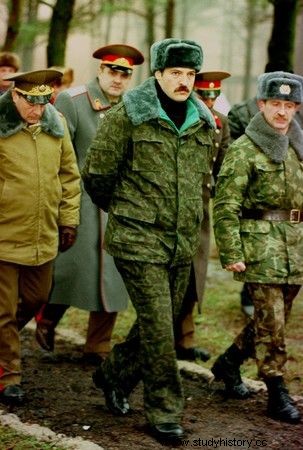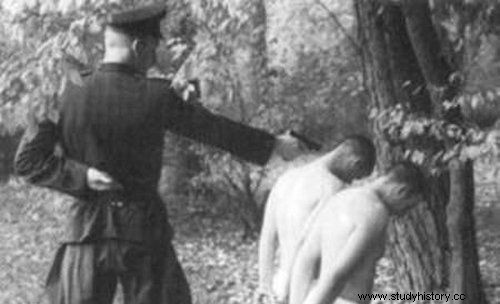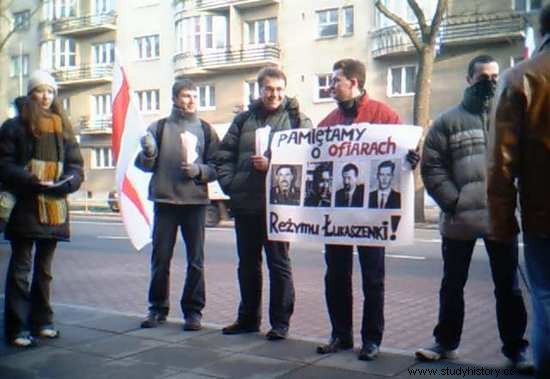Alexander Lukashenka has nothing to do with democracy. He orders his political opponents to be beaten, imprisoned and sent to penal colonies. The most reluctant ones will meet the Special Rapid Reaction Unit - the death commando of the Belarusian dictator.
When Lukashenka was elected president of Belarus in the summer of 1994, he seemed to be an excellent candidate for this position. One quickly showed what he could do. Barely two years later - while working on the amendment of the constitution - on his order, rebellious parliamentarians were beaten up.
It turned out, however, that it was not enough to gag the opposition's mouth. Lukashenka decided to use methods tested by many other dictators. His opponents were to disappear. Forever.
A unit for very special tasks
For this purpose - as they write in their book "Lukashenka. The would-be tsar of Russia "Andrzej Brzeziecki and Małgorzata Nocuń - a group of thugs was created:
ready to obey any presidential order, including shooting the heart (or rather the back of the head) of a rebellious politician . The group called the Special Rapid Reaction Unit, or SOBR, was supposed to be secret, but operated within the structures of the state.

In 1994 Lukashenka seemed to be a good candidate for president, but he quickly showed what he could do (photo:materials from the book "Lukashenka. The would-be Tsar of Russia").
The formation of the unit began in 1996. Its members were secretly recruited from among the soldiers of the Belarusian special forces, and Colonel Dmitry Pavlichenko was appointed commander. The entire operation was supervised by Viktar Sheiman (at that time the secretary of the State Security Council) and Yuri Sivakou (minister of the interior).
Obviously, Lukashenka's executors were not treated like ordinary thugs. For Belarusian conditions, they lived in real luxury. Even a special town was built for them near Minsk, where they lived and learned their new profession.
SOBR goes hunting
Before the death commando started to eliminate Baćka's political opponents - as Lukashenka is called - it was necessary to select "training" targets. After all, it was impossible to allow the troops to be in the ranks of the unit who would not be able to kill a man in cold blood.
It was the gangsters and the homeless - people that nobody calls up for. As emphasized by the authors of Lukashenka's biography, two birds were baked with one stone in this way : the commandos got used to blood, and at the same time the criminal world was liquidated in Belarus.
Once a group of trusted enforcers had been selected, Aleksandr Grigoriewicz decided it was high time to deal with the most dangerous political opponents. These people - it was spring 1999 - were preparing independent presidential elections.

Shot to the back of the head. Exactly the same technique of killing their victims was used by the members of the Special Rapid Reaction Unit - Lukashenka's death commando.
Among the rebellious was also the widely respected former Minister of Internal Affairs, Colonel Jura Zacharanka. Disagreeing with the dictator's policy, he decided to organize an independent Union of Officers, which quickly gained great popularity.
It was too much for Lukashenka. He felt threatened and had to do something about it. The decision was made and on the evening of May 7, 1999, Zacharanek, returning to his home, disappeared under mysterious circumstances . Thus began a series of mysterious "disappearances" of Belarusian oppositionists.
Three months later, a similar fate befell Wiktor Hanczar - former chairman of the Central Election Commission and the originator of alternative elections. On September 16, he made an appointment with his friend Anatol Krasouski for a meeting in sucks. Neither of them came home yet. Their bodies were also not found.
But this is not the end. On July 7, 2000, a journalist, Dmitry Zawadzki, returning from Chechnya, "disappeared" at the Minsk airport. He, too, most likely fell victim to the Special Rapid Reaction Unit. Interestingly, he did not particularly sympathize with the opposition. He was even the personal operator of Lukashenka at one time.
But he made a fatal mistake:he abandoned his employer for a well-paid job on Russian TV. The Belarusian dictator never forgave him. He never forgives.
Pistol with silencer
But how can we be sure that they were all murdered at Baćka's request? Where's the evidence? Any doubts are dispelled by the account of Oleg Alkayev - the former head of the Minsk prison.
It was from him that Colonel Pawliczenka borrowed a pistol with a silencer, which was used to carry out the death penalty - in Belarus people sentenced to death are shot in the back of the head. The date of the colonel's visits always coincided with the "disappearance" of another oppositionist.
When Alkayev realized this, he immediately notified the KGB that had initiated the investigation. Pawliczenka was quickly arrested, who clearly stated: I was just following the president's orders . However, the case never went to court.
At the personal request of Lukashenka, the investigation was quickly closed, and the head of the Belarusian prosecutor's office said goodbye to his position - he asked too many uncomfortable questions. The only effect of all the confusion was the dismissal of Sheiman. But he was not hurt either. Baćka "as a punishment" appointed him ... the prosecutor general .

Demonstration of Belarusians and Poles in front of the building of the Ministry of Foreign Affairs in Warsaw with portraits of Belarusian "missing" people. December 12, 2003 (photo:Bladyniec; license CC BY-SA 3.0)
The final record of the activities of Pavliczenko and his people is unknown. Most likely, more than 30 people fell victim to the garbage commando . Their bodies were secretly buried in one of the cemeteries in Minsk. At least that's what Dmitrij Pietruszkiewicz and Aleh Słuczak said. Two former investigators of the Belarusian prosecutor's office who fled to the West in 2001. Oleg Alkayev, fearing for his life, followed in their footsteps.
Source:
Trivia is the essence of our website. Short materials devoted to interesting anecdotes, surprising details from the past, strange news from the old press. Reading that will take you no more than 3 minutes, based on single sources. This particular material is based on:
- Andrzej Brzeziecki, Małgorzata Nocuń, Lukashenka. The would-be Tsar of Russia , SIW Znak 2014.
